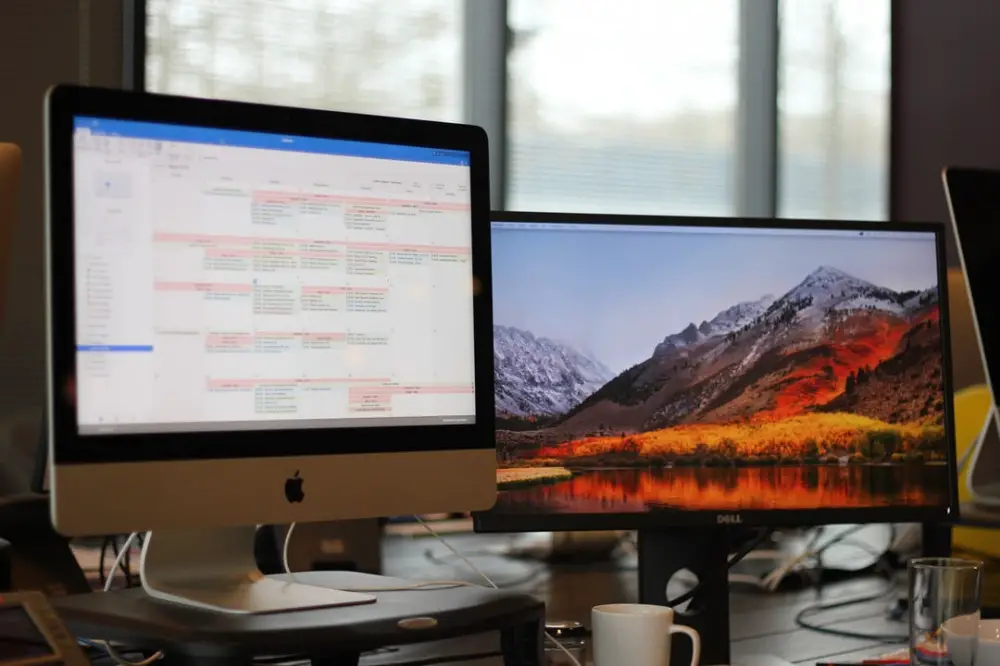With germs rampant and devices constantly being handled, our device screens are a feeding ground for dirt and fingerprints. While regularly cleaning our hands will help, it won’t eliminate the issue. Let’s find out exactly how to clean a blue light screen protector? Also, discover what cleaning agents you should avoid when cleaning your blue light screen protector.
If you’re in a hurry, here is a site I recommended for office equipment with lifetime guarantee!
How to clean a blue light screen protector
For cleaning any screen surface, the best item to use is simply a microfiber cloth. These are designed to clean screens without leaving lint behind or damaging the screen.
The below steps should be followed when cleaning a blue light screen protector on a mobile, tablet or computer:
- Use a microfiber cloth to polish the screen and remove smudge marks and germs.
- Use an electronic cleaning wipe to clean the screen down to remove any dust or fingerprints present on the screen.
- Allow the screen to dry for about 5 minutes, if you don’t have time, skip to the next step.
- Using a lint-free cloth, dry off the screen by gently wiping it down.
- Clean your blue light screen protector as often as necessary to minimize dirt, smudges and fingerprints building up.
- Items which are held often, such as phones and tablets, should be cleaned about twice a week.
- Laptop and computer screens can usually last a week without being cleaned.
The only cleaning materials that should be used include a lint free microfiber cloth and wet wipes designed for electronic devices. This will help ensure optimal functioning of your device and minimize the amount of damage to your blue light screen protector.
A study has shown that people who were exposed to blue light in the evening didn’t release as much melatonin. Consequently, their sleep cycles were disrupted or delayed. Source

Considering that we handle our phones and devices so often, good hygiene and a regular cleaning schedule is essential. What’s also important is cleaning your device the correct way and using the correct cleaning materials that won’t damage your precious gadget. Luckily for you, this is covered in the upcoming sections!
What cleaning materials should I use to clean a screen protector?
The best cleaning material to use for a screen protector is simply a microfiber cloth. Generally, this will remove the majority of dust and marks. However, wetting the microfiber cloth with water may be necessary to remove persistent smudge marks.
Furthermore, reaching out to the manufacturer or checking the cleaning instructions will give you more detail.
I reached out to Ocushied to ask them how to clean Ocushield anti blue screen protectors. They provided the below response:
An alcohol gel is fine to use on an iPhone Ocushield screen.
Ocushield screen protectors have oleophobic coatings which protect against oils and withstand disinfection ingredients. We suggest using soap and water on a tissue or sponge to wipe surfaces. Soap is very good and safe.
Depending on how protective and exact you are about the cleaning methods for your device, you can either take the more stringent approach and conservative approach.
Alternatively, if you don’t think you’ll notice the difference, or you’re not too bothered, you can be a bit looser less strict about the exact types of cleaning agents that you use.
Some people are happy enough to use multi-surface cleaning wipes as opposed to purchasing dedicated screen wipes.
Most screen protectors come equipped with an oleophobic coating. This is an oil-repellant layer which eliminates or minimizes the number of smudges and fingerprints on the screen.
If you want to protect the oleophobic coating on your screen protector, then adopting the conservative approach is the best method.
If you’re not too worried about affecting the oleophobic coating or you want to disinfect the screen protector, then you can use the likes of Lysol or Clorox wipes to clean the screen and paper towels to dry the screen.
If your screen protector doesn’t have anti-glare properties, you could invest in a dimmable light. This will help to minimize glare on your screen.
Plus, with the recommended product that I listed below, this adjustable light will also allow you to point the light in the correct direction.
Thus, it’ll help to minimize eye strain and also reduce your exposure to blue light.
Recommended product: LED light, flicker-free, dimmable + lifetime warranty
Dos and don’t of cleaning a screen protector
What to do when cleaning your screen protectors
- Switch off and unplug your device before you begin cleaning it
- Use clean microfiber cloths for wiping the screen
- Wet the microfiber cloth if smudges persist
- Wring out the cloth to ensure it is not too wet when cleaning the device
- Check the manufacturer’s website for approved cleaning techniques and materials
- Use wet wipes designed for cleaning device screens
- Use rubbing alcohol with a low isopropyl alcohol concentration (<70%), but only if approved by the manufacturer
Tip: Some anti-bacterial multi-surface wipes can be used to clean down an electronic screen, such as Lysol wipes on certain Apple devices. Just check the label to make sure.
What to avoid when cleaning your screen protectors
- Avoid spraying liquids onto the phone
- Avoid bleaches, hydrogen peroxides, aerosol sprays or
- Avoid abrasive materials that could scratch the screen
- Avoid using a corner of your t-shirt or your pants to wipe your device screen
- Avoid Windex or Clorox which can remove the protective oleophobic (oil-repellent) coating
Tip: If you prefer not to use blue light screen protectors, an alternative is blue light glasses.
Related: How To Choose Blue Light Screen Protectors – 10 Easy Steps!
Conclusion
Following some simple techniques along with using the correct cleaning supplies can ensure that you protect your device and your blue light screen protector from damage and dirt.
You will see conflicting reports regarding what materials can be used to clean a screen protector.
If you are unsure of how to clean the blue light screen protector properly, ensure that you adopt the more conservative approach of using a microfiber cloth and dampen it if necessary.
Using rubbing alcohols at too high of a concentration or abrasive cleaning materials could remove the protective oleophobic (oil-repellent) layer on the screen.
Fortunately, most of the top blue light screen protectors will have a 1-year guarantee.
Of course, you could avoid the hassle of cleaning by opting for blue light filter apps instead.
If you’re currently undecided, I compare the pros and cons of Blue Light Screen Protector V Blue Light App + Helpful Tips! in this easy to follow article.
Do you own any blue light glasses or anti blue light protection products? How often do you clean them? I’d love to hear your thoughts and opinions in the comments below.
